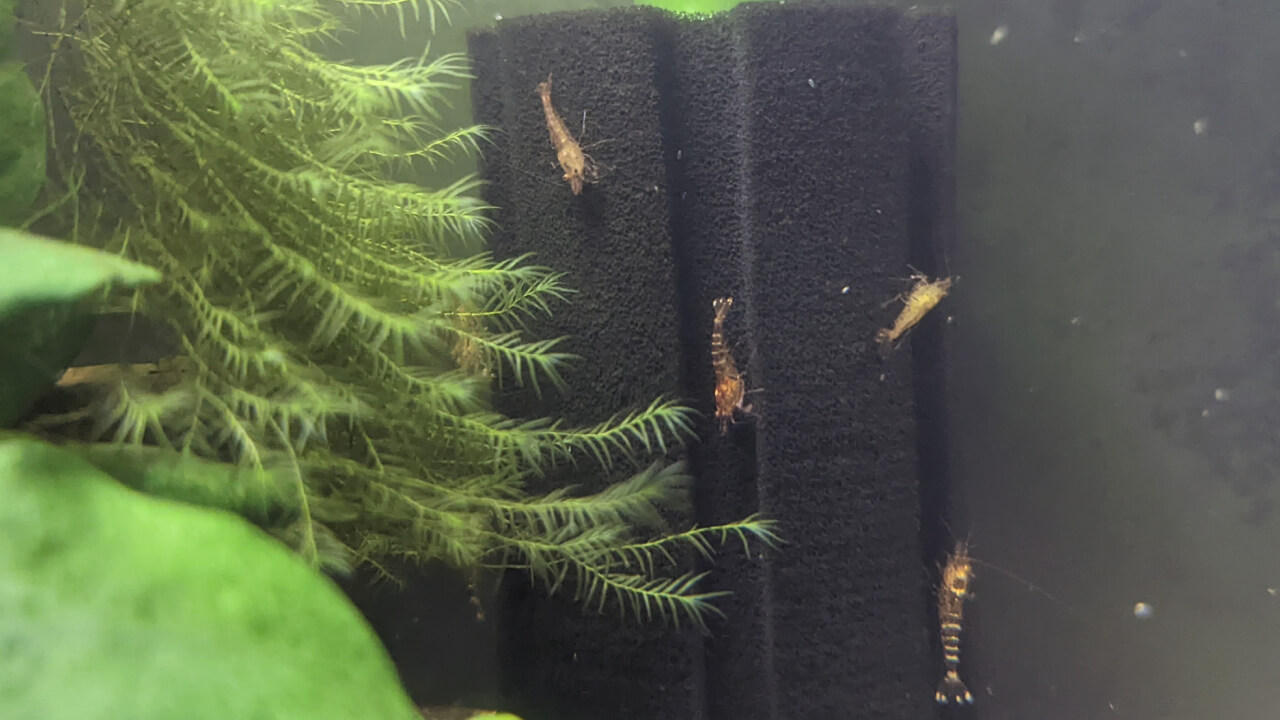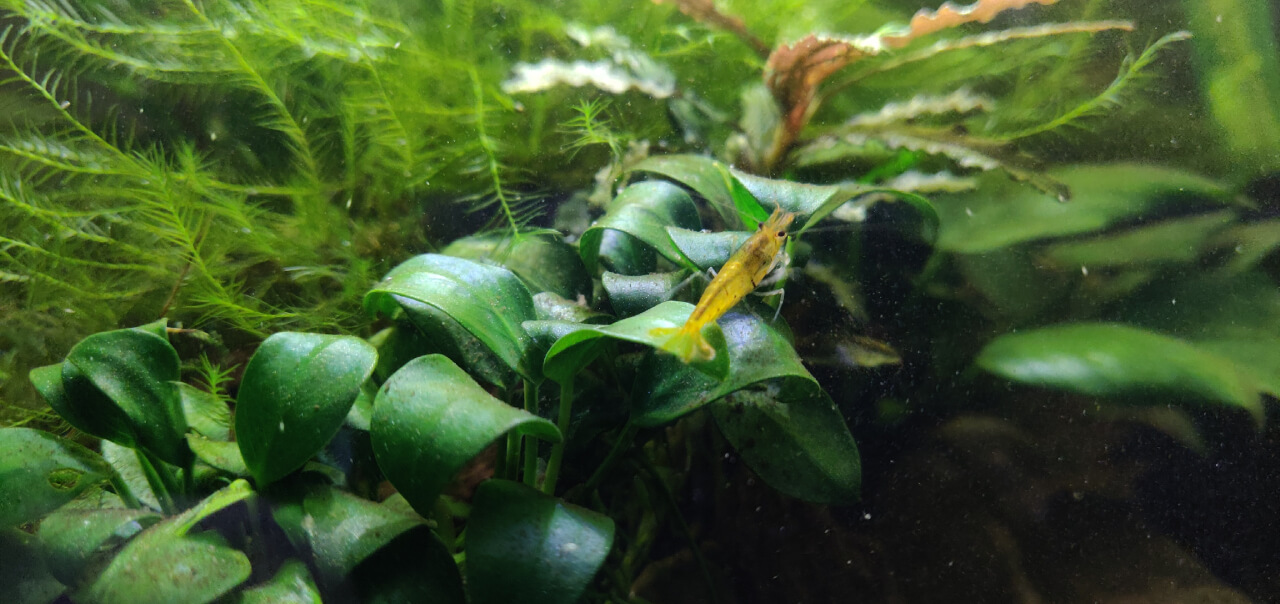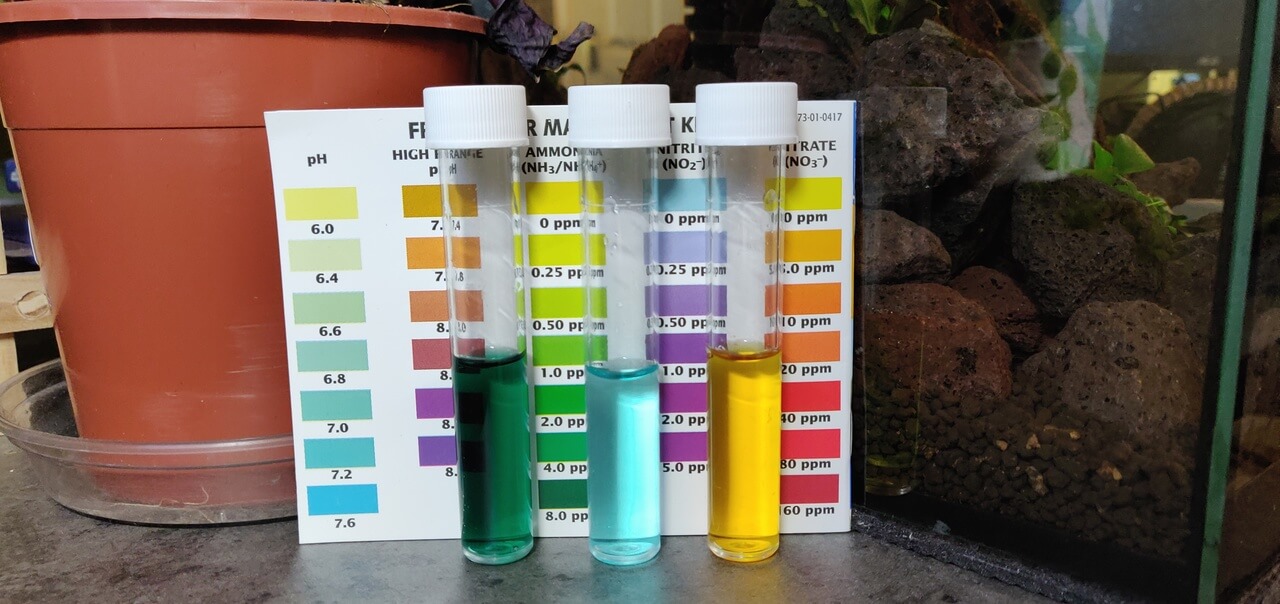What is cycling?
Simply put, cycling an aquarium means building up a large enough colony of beneficial bacteria in your filter to safely consume your animals’ waste before it can cause them health/stress issues.
Having a fully cycled tank is especially important for shrimp as they’re highly sensitive to toxic elements like ammonia. It’s recommended to let your tank cycle and mature for about 4-6 weeks before you add shrimp.
In more technical terms, your shrimp will produce ammonia (NH4) as waste which can be toxic to them even in small amounts. To prevent a build up of ammonia you should allow certain beneficial bacteria, called Nitrosomonas, to grow a healthy population. This bacteria will consume the ammonia and produce something called nitrite (NO2).
However, whilst nitrite is less dangerous than ammonia, it is still toxic to shrimp and so another type of bacteria is required to finish the job: Nitrospira.
Nitrospira takes in the nitrite (NO2) and breaks it down into nitrate (NO3) which is much less harmful, and can then be more easily absorbed by plants etc.
The healthy plant growth will also provide more surface area for biofilm and algae to grow, which will make up a large part of their diet.
These beneficial bacteria colonies grow mostly in your filter and on the porous surfaces/materials with high surface area such as filter sponge, lava rock, ceramic bio rings, etc.
How long does it take?
As a rule of thumb, the cycling process is complete once there is 0ppm of ammonia and nitrite.
Before adding any shrimp to the tank though, you should check that the nitrate levels aren’t super high. A simple water change is a quick and safe way to bring down the nitrates.
You must be patient as the cycling process can take around 4-6 weeks to complete. You can speed up the cycling time by using ready-made bacteria products or “seeding” your new filter with media from an already established filter. This is explained in more detail later.
Even though you can seed your tank with starter bacteria, you should try and let your tank mature for a few weeks to give time for biofilm to grow over all the hardscape and walls etc. This will give your new shrimp a fantastic head start and help to reduce the risk of any deaths whilst they adjust.
Types of filtration
There are many different types of filter available, but you should be careful to choose a filter that’s safe for shrimp. You don’t want any small shrimp babies getting accidentally sucked into a pump intake and getting trapped in the filter.
Typically filters will serve up to three purposes: biological, mechanical, and chemical.

Biological filtration
This is a technical way of describing where the most of the beneficial bacteria will live.
Typically filters like a hang-on-back or canister will hold lots of porous material or “media”, to provide lots of surface area for the bacteria to live on. Some examples include ceramic bio rings, bio balls, sponges, and lava rocks.
Pushing the water over the media with your beneficial bacteria gives them plenty of time to process the unwanted elements like ammonia.
Mechanical filtration
Mechanical filtration catches the loose debris floating around your tank, keeping your water looking crystal clear. Filter floss and sponges are the most common types of mechanical filtration media. Note that sponge filters perform both biological and mechanical filtration.
Chemical filtration
The final type of filtration is chemical filtration. This is the addition of an element which will change the water chemistry in some way, such as activated carbon. Activated carbon will trap chlorine/chloramine, tannins (the cause of dark water), and likely any medications you’ve added to the water too.
The activated carbon works by trapping the elements in tiny pores on its surface. As a result, it will only work efficiently for a limited amount of time depending on how much trapping it does.
To use it efficiently you should always place chemical filtration after mechanical filtration (i.e. behind filter floss) to prevent larger bits of general debris from clogging up the “traps”.
How to cycle a shrimp tank
Requirements
The fishless cycling process is the recommended method of cycling a new aquarium, as it won’t put any stress on your shrimp.
- Source of ammonia (e.g. Amazonia substrate)
- Aquarium water test kit
- A shrimp safe filter
Basic steps
The basic steps for cycling are:
- Set up a filter
- Add a source of ammonia
- Wait for the ammonia to be converted into nitrites
- Wait for the nitrites to be converted into nitrates
If you’re setting up a tank for soft water Caridina shrimp you’ll probably be using an active substrate like ADA Aqua Soil Amazonia. This substrate contains ammonia already so it’s as simple as plugging in your filter and waiting.
However, if you don’t have an active substrate you’ll need to add ammonia manually.
Once your test kit shows that both ammonia and nitrites have reached zero again, and you have some nitrates showing, your cycle has finished. Perform a water change to reduce the nitrates a little before adding your new shrimp. You should use the drip acclimation method to give them the best start.
Fish food method
The easiest way of introducing some ammonia to your tank is to sprinkle some fish food into it for a few days. Obviously as there is nothing in there yet to eat it, it’ll break down and decay, producing the ammonia we want.
You don’t need to go crazy with the fish flakes, just a pinch or so every day for the first week should be plenty.
Pure ammonia method
An alternative way is to add some pure ammonia solution such as Dr Tim’s Ammonium Chloride. Be careful to check that the ammonia solution is pure and does not contain any perfume.
Add the ammonia solution until you reach about 2-4ppm showing on your ammonia test kit. After a few days you should start seeing the ammonia level drop and the nitrite level increase.
This is when you’ll want to add some more ammonia to get back to the 2-4ppm range. Keep the ammonia around this level for the first week or so to keep the beneficial bacteria growing.
Other ways to improve cycling
Plants
There are many benefits to adding plants to a shrimp tank: increased surface area for biofilm and algae to grow, absorbing excess ammonia/nitrates, and giving the shrimp places to hide after molting.

Floating plants specifically are incredible at absorbing ammonia and nitrates from the water. Combined with having access to the CO2 in the air, they grow very quickly and help to keep your nitrates low.
One thing to be careful of is that you might need to dose aquatic plant fertilizer like Seachem Flourish into the tank depending on how demanding the plants are. Some of these fertilizers might contain copper, which can be very toxic to shrimp so ensure that the amount is miniscule or non-existent to be safe.
Walstad method
The Walstad method is a process of setting up a planted tank which involves putting soil at the bottom of the tank and then capping it with gravel. This allows the plants to access all of the nutrients they need via their root systems and you won’t need to worry about dosing fertilizers into the water column.
Walstad tanks rely on the large amount of plants to process the ammonia into safer elements for your shrimp.
Seeded filter
If you have another aquarium that’s already cycled, you can take some filter media from it and move it to the new tank.
You can also run a second sponge filter in the older tank for a week or so to seed it with beneficial bacteria.
Bacteria in a bottle
If you don’t have access to seeded filter media (i.e. a sponge taken from an already cycled tank) then there are some products you can buy that aim to speed up the bacteria population growth.
Some examples of this are API Quick Start, Tetra SafeStart, and Seachem Stability.

